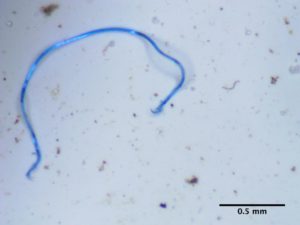 Did you know that you are eating teeny tiny bits of plastic in your food every day? And inhaling the pieces floating in the air? These tiny bits of plastic are called microplastics, and are from all the plastic breaking down (degrading) in the environment. They have entered the food chain (e.g. from fish and other animals ingesting bits of plastic, food preparation, or from plastic packaging), and in this way we are also ingesting microplastics. They vary in shape and size, but some pieces can be so small that they can only be seen with a microscope.
Did you know that you are eating teeny tiny bits of plastic in your food every day? And inhaling the pieces floating in the air? These tiny bits of plastic are called microplastics, and are from all the plastic breaking down (degrading) in the environment. They have entered the food chain (e.g. from fish and other animals ingesting bits of plastic, food preparation, or from plastic packaging), and in this way we are also ingesting microplastics. They vary in shape and size, but some pieces can be so small that they can only be seen with a microscope.
The problem is that microplastics can enter our body several ways (through ingestion get into the gut and so get into human tissues, or through inhalation into the lungs). They could trigger an immune response, or the plastic could release chemicals, such as carcinogens or endocrine disruptors. Unfortunately, the health effects from microsplastic ingestion are unknown.
A study by Canadian researchers looked at all available evidence from 26 studies to try to get some idea of how many microparticles of plastic Americans ingest over one year. The researchers estimate that annual consumption of microplastics ranges from 39,000 to 52,000 particles (depending on age and sex). When they added in inhalation of microplastic particles, the numbers increased to 74,000 to 121,000. And those who only drink bottled water may be getting an additional 90,000 microplastics (versus about 4000 microplastics from tap water).
These numbers are for about microplastics found only in certain foods (fish, shellfish, sugars, salts, honey, alcohol) that add up to about 15% of the diet. But the number of microplastics in other foods (such as fruits, vegetables, meats, grains) have not been studied. The researchers point out that we ingest microplastics that are in the air and settle on our food during meal preparation and during meals. So the actual numbers of microplastics that are ingested each year are certain to be much higher! [Microplastics are even in our house dust.]
What can one do to lower the number of microplastics that we eat? Number one, drink tap water or bottled water in glass bottles, and less water from plastic bottles. Since no one knows about how many plastic particles are in other foods, one possibility may be to eat more foods and beverages that come in glass containers, rather than plastic containers. As the researchers point out, microplastic research is still in its infancy. They also felt that since this study only looked at certain foods, then they really underestimated how many microplastics Americans ingest each year.
From Science Daily: Americans consumer 70,000 particles of microplastics per year
Since the mass production of plastics began in the 1940s, the versatile polymers have spread rapidly across the globe. Although plastics have made life easier in many ways, disposing of the materials is a growing problem. Now, researchers in the ACS journal Environmental Science & Technology estimate that the average American consumes more than 70,000 particles of microplastics per year, though the health effects of that consumption are unclear.
Microplastics are tiny (often microscopic) pieces of plastic that can arise from multiple sources, such as the degradation of larger plastic products in the environment, or the shedding of particles from food and water containers during packaging. Humans can inadvertently take in the materials when eating food or breathing air containing microplastics. The health effects of ingesting these particles are unknown, but some pieces are small enough to enter human tissues, where they could trigger immune reactions or release toxic substances. But how much microplastics do humans consume? That's the question Kieran Cox and colleagues wanted to tackle.
To do so, the researchers reviewed 26 previous studies that analyzed the amounts of microplastic particles in fish, shellfish, added sugars, salts, alcohol, tap or bottled water, and air. Other foods were not included in the analysis because the data were lacking. The team then assessed approximately how much of these foods men, women and children eat from the recommended dietary intakes of the 2015-2020 Dietary Guidelines for Americans. From this analysis, the estimated microplastic consumption ranged from 74,000 to 121,000 particles per year, depending on age and sex. People who drink only bottled water could consume an additional 90,000 microplastics annually compared with those who drink only tap water. Because the researchers considered only 15% of Americans' caloric intake, these values are likely underestimates, they say. Additional research is needed to understand the health effects, if any, of the ingested particles.
